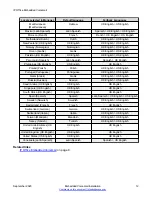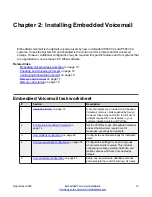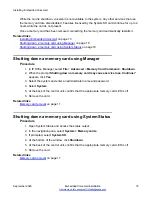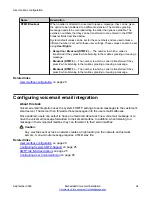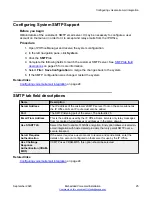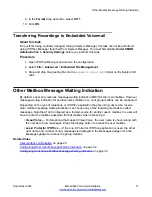
Chapter 3: User mailbox configuration
Embedded voicemail creates a mailbox for each user on the system. Direct calls to a user are
routed to their mailbox whenever the user's extension is busy or does not answer within the users
allocated
No Answer Time
. This includes calls that are forwarded to another internal
destination.This chapter describes how to configure an individual user's mailbox by configuring the
user settings in IP Office Manager. An individual user's mailbox can also be configured through the
mailbox and system short codes (see the IP Office Embedded Voicemail User Guide for more
information).
User mailbox features include:
•
Message Waiting Indication
– If supported by the user's current telephone, the user will
receive message waiting indication whenever their mailbox contains new messages. The type
of message waiting indication will depend on the telephone.
•
Mailbox access
– The standard default short code (*17) can be used to access an extension's
associated user mailbox. Other methods of mailbox access can be configured.
•
Visual Voicemail
— The MESSAGES button on phones, which normally emulates *17, can be
configured to access Visual Voice mode on phones that support Visual Voice. This is done
using the
Messages Button Goes To Visual Voice
(
System
>
Voicemail
) option.
•
Ringback
– Embedded voicemail can be set to ring the user whenever they have new
messages in their mailbox. This ringback is triggered after the completion of a call at the user's
extension. Ringback from a hunt group mailbox containing new messages may also occur if the
user is configured to receive hunt group message waiting indication.
•
Voicemail on or off
– Sending calls to the user's mailbox can be switched off. Note however
that this does not stop other methods of leaving messages directly in the user's mailbox.
•
Access code
– An access code can be assigned to the mailbox. Anyone accessing the
mailbox must first enter this code before they can collect messages. The access code can be
reset by the user once they are in their mailbox.
•
Reception/DTMF breakout numbers
– Options can be configured that allows callers to dial 0,
2 or 3 when they hear the mailbox greeting to be transferred to another number rather than
leave a message. For example, dial 0 to be transferred to the receptionist. When used, these
features should be announced in the mailbox greeting. The breakout numbers can be defined
at the system level for application to all mailboxes or separately at the individual user level.
•
Announcements
– Embedded voicemail allows announcements to calls waiting to be
answered by users. This is similar to the announcements provided for hunt groups, with
announcements being played to callers waiting to be answered. Due to the overlap of various
timeouts, the use of user announcements is not recommended in conjunction with forwarding
and voicemail.
September 2020
Embedded Voicemail Installation
20







